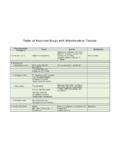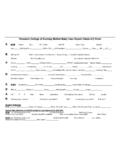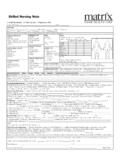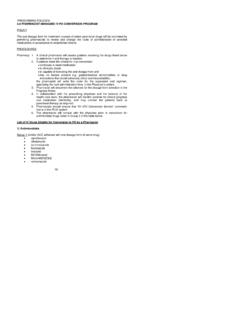Transcription of Hypertensive Urgencies and Emergencies.ppt
1 HYPERTENSIVEURGENCIES ANDEMERGENCIESDEFINITIONS Systolic blood pressure >220 and diastolic >120mmHg. Patients with hypertension can be classified into 2 categories based upontheir symptoms and the organ systems that are affected at the time ofpresentation: - Hypertensive URGENCY: the BP is a potential risk but has not yetcaused acute end-organ damage. These patients require BP control overseveral days to EMERGENCY (AKA ACCELERATED OR MALIGNANTHYPERTENSION): is severe hypertension with acute impairment of anorgan system ( , central nervous system [CNS], cardiovascular, renal).In these conditions, the blood pressure (BP) should be loweredaggressively over minutes to of papilledema indicatesHYPERTENSIVE ENCEPHALOPATHYis accelerated or malignanthypertension with CNS signs or symptomsETIOLOGY Essential hypertension: Inadequate blood pressure control and noncompliance are commonprecipitants Renovascular Eclampsia/pre-eclampsia Acute glomerulonephritis Pheochromocytoma Anti- Hypertensive withdrawal syndromes Head injuries and CNS trauma Renin-secreting tumors Drug-induced hypertension Burns Vasculitis TTP Idiopathic hypertension Post-op hypertension Coarctation of aortaTake home message The commonest cause of hypertensiveemergency in 2011 is undiagnosed,untreated, or undertreated essentialhypertensionPATHOPHYSIOLOGYNORM ALAUTOREGULATIONRISE IN BPARTERIAL ANDARTERIOLARCONSTRICTIONN ormal flow.
2 (flow=P/r)RISE IN BPFAILURE OFVASOCONSTRICTIONENDOTHELIAL DAMAGE(due to shear stress on thewall)AUTOREGULATIONFAILUREPATHOPHYSIO LOGY BP=PVR*CO(SV*HR) Rate at which MAP rises more important than absolute rise in BPFailure of vasoconstrictionEndothelialby autoregulationdamageFIBRINOIDA ctivates coagn andDepsn. of proteins/NECROSIS inflammationfibrinogen in vessel wall RAAS plays an important role in initiating and perpetuating BP rise by causingvasoconstriction and fluid NERVOUS SYSTEM CENTRAL NERVOUS SYSTEM: The CNS is affected as the elevated BPoverwhelms the normal cerebral autoregulation. Under normal circumstances, withan increase in BP, cerebral arterioles vasoconstrict and cerebral blood flow (CBF)remains constant. During a Hypertensive emergency, the elevated BP overwhelmsarteriolar control over vasoconstriction and autoregulation of CBF. This results intransudate leak across capillaries and continued arteriolar damage. Subsequentfibrinoid necrosis causes normal autoregulatory mechanisms to fail, leading toclinically apparent papilledema, the sine qua non of malignant hypertension.
3 The endresult of loss of autoregulation is Hypertensive SYSTEM The cardiovascular system is affected asincreased cardiac workload leads tocardiac failure; this is accompanied bypulmonary edema, myocardial ischemia, ormyocardial SYSTEM The renal system is impaired when high BPleads to arteriosclerosis, fibrinoid necrosis,and an overall impairment of renalprotective autoregulation mechanisms. Thismay manifest as worsening renal function,hematuria, red blood cell (RBC) castformation, and/or In the US:More than 60 million Americans, about 25-30% of thepopulation, have hypertension. Of these individuals, 70% have milddisease, 20% moderate, and 10% severe hypertension (diastolic BP [DBP]>110 mm Hg). Approximately 1-2% develop a Hypertensive emergencywith end-organ damage. Mortality/Morbidity:Morbidity and mortality depend on the extent of end-organ damage on presentation and the degree to which BP is controlledsubsequently. BP control may prevent progression to end-organimpairment.
4 I yr mortality in untreated pts. >90%.5 yr survival of allpresentations is 74%. Race:African Americans have a higher incidence of hypertensiveemergencies than Caucasians. Sex:Males are at greater risk of Hypertensive emergencies than females. Age:Most commonly in middle-aged Focus on circumstances surrounding hypertension & etiology :-Medications:esp. Hypertensive drugs/their compliance,illicit drugs-Duration of hypertension-Duration of current symptoms-Date of LMP-Other medical problems:priorhypertension,thyrotoxicosi s,Cushing s,SLE,renal Focus on complications :-CNS:headaches,blurred vision,wt. loss,nausea,vomiting,weakness,fatigue,co nfusion and mental status :symptoms of CHF,angina,dissection,SOB-Renal:hematuri a, Use an approach based on organ systems to identify signs of end-organ damage-CNS: focal neuro deficits,seizures,stupor,coma, papilledema,hemorrhages, exudates, or evidence of closed-angle glaucoma-CVS:JVD,lung auscultaion for crackles,peripheral edema,extraheart sounds,equal and symmetric BP and pulses for abdominal masses and Coronary SyndromeAortic dissectionCHF,pulmonary edemaAcute Coronary SyndromeAneurysm, AbdominalAnxietyCongestive Heart Failure and Pulmonary EdemaCushing SyndromeDelirium TremensEncephalitisGlomerulonephritis, AcuteHeadache, ClusterHeadache, MigraineHeadache, TensionHyperthyroidism, Thyroid Storm, and Graves DiseaseMyocardial InfarctionPregnancy, EclampsiaPregnancy, PreeclampsiaStroke, HemorrhagicStroke, IschemicSubarachnoid HemorrhageSystemic Lupus ErythematosusDifferential(contd.)
5 Others:-Steroid use-Use of over-the-counter or recreationalsympathomimetic drugs-Pheochromocytoma-Acute vasculitis-Serotonin syndrome-Other CNS pathology-Coarctation of the aortaWork-up CBC,Chem 8 Urinanalysis:hematuria,proteinuria,RBCs, RBC casts. Toxicology,pregnancy,endocrine causes. Imaging:Chest X-ray,Head CT,Chest CT,aortic angiogram EKG,cardiac enzymesTREATMENT Weigh benefits of decreasing BP against risks of decreasing end-organ perfusion. Important steps include:-Appropriately evaluating patients with an elevated BP-Correctly classifying the hypertension-Determining aggressiveness of therapyAn important point to remember in the management of the patientwith any degree of BP elevation is to"treat the patient and not thenumber."Treatment Initial considerations:Place patient who is not in distress in a quietroom and reevaluate after an initial interview. In one study, 27% of patientswith an initial DBP >130 mm Hg had their DBP fall below critical levels afterrelaxation without specific treatment.
6 Consider the context of the elevated BP (eg, severe pain) Screen for end-organ damage-Patients with end-organ damage usuallyrequire admission and rapid lowering of BP using iv medsdepend on the end-organ system damaged. Patients without evidence of end-organ effects may be discharged withfollow is a misconception that a patient should not be discharged fromthe ER with elevated oral meds such as nifedipine to rapidlylower BP may be dangerous as the BP may have been elevated forsometime and there may be organ control has notimproved long term mortality and morbidity STEPS Initial considerations:Place patient who is not in distress in a quietroom and reevaluate after an initial interview. In one study, 27% of patientswith an initial DBP >130 mm Hg had their DBP fall below critical levels afterrelaxation without specific treatment. Consider the context of the elevated BP (eg, severe pain) Screen for end-organ damage-Patients with end-organ damage usuallyrequire admission and rapid lowering of BP using iv medsdepend on the end-organ system damaged.
7 Patients without evidence of end-organ effects may be discharged withfollow is a misconception that a patient should not be discharged fromthe ER with elevated oral meds such as nifedipine to rapidlylower BP may be dangerous as the BP may have been elevated forsometime and there may be organ control hasnot improved long term mortality and morbidity Once the diagnosis of hypertension is made and end-organ damage confirmed,the BP should be lowered byabout 25% of the mean arterial pressure. There are 2 main classes of drugs:-Vasodilators-Adrenergic ,cyanide poisoningNitroglycerine5-100mcg/min1-5mi n/3-5minFlushing,headache,methemoglobinN icardipine5-15mg/hr5-10min/1-4hrTachycar dia, failureHydralazine10-20mg5-15min/3-8hrFl ushing,tachy, ,MIEnalapril10-40mg IM, ,renalfailure, ,headache, (a+b blocker)20-80mgiv bolusevery 10min, ivinfusion5-10min/3-6hrsHeart block, failure,asthmaEsmolol(b-1 selectiveblocker)200-500mcg/kg/min for4min,then 150-300mcg/kg/min1-2min/10-20minHypotens ion,avoid-heart failure,asthmaPhentolamine(a1 blocker)5-15mg iv1-2min/3-10minTachycardia,flushing,hea dacheADRENERGIC INHIBITORSORAL DRUGSDRUGDOSAGEONSET/DURATIONADV.
8 (ACE inhibitor) q in highrenin statesCLONIDINE(a2 agonist-centrallyacting) mg hrly,Upto max ,bradycardia,dry mouthLABETALOL100-200mg q 12hrs30-120min/8-12hrsHeart failure,heartblock,bronchospasmRAPID BP REDUCTION Acute myocardial ischemia:IV NTG,b-blockers,ACEinhibitors. CHF with pulmonary edema:ivNTG,furosemide,morphine Acute aortic dissection:iv nitroprusside+b-blockers or ivtrimethaphan+b-blockers. Hypertensive encephalopathy or sub-arachnoidhemorrhage:iv nitroprusside,labetalol or nimodipine. MAO-tyramine interactions with acute TREATMENT Hypertensive Encephalopathy:Goalis to reduce MAP by not>25% or DBPtp100mmHg in the first (widely used in past)is a powerful arteriloar dilator,so arise in ICP may ,fenoldopamused more now. Intracerebral Hemorrhage:CPP= ICP rises,MAP must rise for perfusionbut this raises risk of bleeding from small arteries and prosp. Obs. study in 1997 didnot confirm these concerns but it was obscured by early use of curve in chronic hypertensives may be altered,making them less likely to tolerateaggressive lowering of guidelines:decrease when MAP>130 orSBP> ,esmololagents of choice.
9 SAH:Nimodipinedecreases vasospasm that occurs due to chemical irritation of arteries recommended routinely due to high incidence of status is ,esmolol agents of choice. Acute Ischemic Stroke:High BP can cause hemorrhagic transformation of infarct,cerebral ,if CPP is low,ischemic penumbra may beyond obstn is become dilated with ,loss of decilne to pre-stroke values in 4 days hasbeen documented Cochrane review examining 65 RCTs with 11,500 pts. Concluded thatinsufficient data exists to evaluate BP lowering guidelines:BP be reduced only ifSBP>220 or DBP>120mmHg.(unless end-organ damage is due to BP).Labetalol,nitroprusside-agents of thrombolysis,BP<185 year old European malePresents to ED with 3 day history headaches and visual blurringHistoryWas briefly on blood pressure medication 7 years went for follow-upO/EBP 240/140 Fundoscopy haemorrages and exudatesNo other abnormal findingsECG LVH and strain patternCXR LV+, unfolded aorta, clear lung fieldsCreatinine 120 umol/lUrine Dipstick protein 1+ Hypertensive urgency or emergency?
10 Admit or discharge?Oral or IV treatment?GP calls you about:70 year old European femaleNew to his practiceHistory of hypertension, on metoprolol dailyOn routine check has BP 220/100 rechecked by nurse afterperiod of rest 210/95 Exam otherwise OKFundoscopy silver wiring and AV nippingECG electrical LVHU rine Dipstick trace proteinHypertensive urgency or emergency?Requires hospital admission?Oral or IV treatment?78 year old Hypertensive European man admittedwith left hemiparesis. CT head normal. Diagnosisischaemic strokeBP 200/110 How should he be managed over the next 24hours?Is he a candidate for stroke thrombolysis?50 year old Maori man admitted with left hemiparesisCT reveals right intracerebral haemorrage ~ 25ccBP 230/130 How should he be managed over the next 24 hours?A 55 year old man with a history of hypertensionis admitted with sudden onset severe chest painradiating through to the interscapular regionBP 250/140CT scan reveals Type 2 thoracic aortic dissectionHow and where should he be managed?







